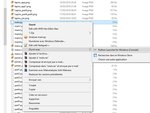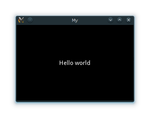La librairie kivy pour python est une librairie qui permet de créer des applications mobiles pour android et iphone.
Ouvrir le terminal
nstallation¶
Now that python is installed, open the Command line and make sure python is available by typing python --version. Then, do the following to install.
-
Ensure you have the latest pip and wheel:
python -m pip install --upgrade pip wheel setuptools
-
Install the dependencies (skip gstreamer (~90MB) if not needed, see Kivy’s dependencies):
python -m pip install docutils pygments pypiwin32 kivy.deps.sdl2 kivy.deps.glew python -m pip install kivy.deps.gstreamer --extra-index-url https://kivy.org/downloads/packages/simple/
-
Install kivy:
python -m pip install kivy
That’s it. You should now be able to import kivy in python.
Note
Installation sous W7, W8, W10
Pour télécharger Kivy. Vous trouverez la doc ici :
http://kivy.org/#download
Il existe des versions portables de Kivy (Python + Kivy) dans un dossier à extraire. Aujourd’hui (mai 2016) il faut installer Python avant d’installer Kivy. Voici les étapes d’après la doc en ligne :
- Installer Python (J’ai pris la 3.4.4, Python 3.5 et Windows ont des problèmes aujourd’hui) :https://www.python.org/downloads/windows/ Installez Python 3.4
Dans un terminal (Tapez cmd dans la recherche d’applications Windows) :
- Allez dans le dossier où se trouve votre installation Python (C :\Python3.4) :
-
cd C:\Python3.4
- Vous pouvez vérifier votre installation Python :
-
python --version
- Installez pip et Wheel :
-
python -m pip install --upgrade pip wheel setuptools
- Installez des dépendences :
-
python -m pip install docutils pygments pypiwin32 kivy.deps.sdl2 kivy.deps.glew
(Gstreamer est assez lourd donc ne l’installez que si vous en avec besoin (cf doc kivy))
- Installez Kivy :
-
python -m pip install kivy
Vous devez maintenant avoir Kivy. Pour tester :
- Ouvrez un éditeur (Notepad, Pyzo...)
- Copier/coller le code suivant :
-
import kivy
-
kivy.require('1.0.6') # replace with your current kivy version !
-
-
from kivy.app import App
-
from kivy.uix.label import Label
-
-
class MyApp(App):
-
-
def build(self):
-
return Label(text='Hello world')
-
-
if __name__ == '__main__':
-
MyApp().run()
- Enregistrez sous main.py
- Clique droit sur le fichier, "Ouvrir avec", "Python Launcher" :
- Votre première application devrait se lancer :
Si vous souhaitez packager vos applications pour Windows et WindowsPhones, je vous laisse lire la doc :
http://kivy.org/docs/guide/packaging-windows.html
The right way to install OpenCV 3.0.0 for python 3.4.2 windows 8.1
- go to http://www.lfd.uci.edu/~gohlke/pythonlibs/#opencv
- download opencv, numpy and scipy
for me I needed
opencv_python-3.0.0-cp34-none-win_amd64.whl
scipy‑0.16.0‑cp34‑none‑win_amd64.whl
numpy‑1.9.2+mkl‑cp34‑none‑win_amd64.whl
- download and install microsoft visual c++ 2010 express from http://microsoft-visual-cpp-express.soft32.com/free-download/
- open command prompt as administrator
- change directory like "cd C:\Users\me\Downloads" to where I downloaded the file
- copy and paste this "python -m pip install -U pip"
- then install the libraries copy and paste this
"pip install opencv_python-3.0.0-cp34-none-win_amd64.whl"
"pip install scipy‑0.16.0‑cp34‑none‑win_amd64.whl "
"pip install numpy‑1.9.2+mkl‑cp34‑none‑win_amd64.whl"
that is all
python -m pip install pyserial






